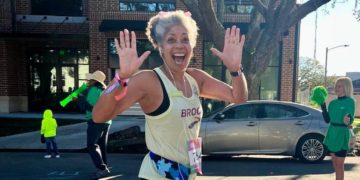When Joice Barnard had a hip replacement just over a year ago, she couldn’t imagine running again without pain, but she was determined to try.
Barnard, 67, has been running for 50 years, longer than some of her fellow marathoners have been alive.
She says a few simple rules have kept her injury-free and in above-average health for her age for decades.
And those same workout tips helped her bounce back from surgery. Earlier this month, Barnard finished her ninth marathon, the Every Woman’s Marathon organized by Team Milk in her hometown of Savannah, Georgia.
“All those illnesses that crop up at my age, I’m still tooling along just fine without any problems. My doctor says, ‘Just keep doing what you’re doing,’” Barnard told Business Insider.
Here are four habits that have helped her keep up the pace:
Avoid doing too much
One of the most common mistakes people make with workouts is overdoing it, and it can happen to everyone from beginners to seasoned athletes.
“For anybody, whether they’re somebody with a hip replacement or they’re 20 years old and they’re very, very fast, it’s so easy to run too many miles a week,” Barnard said.
It might feel like more miles of training or hours in the gym is better in the moment, but coaches recommend building up gradually to reduce the risk of injury.
Barnard said she always takes a slower, steady approach to training, working her way up to longer runs over a period of months.
“I think that people need to be patient with themselves,” Barnard said.
Stick to a plan
Barnard trusts in her training schedule on days when she doesn’t feel like exercising, and is committed to four days of running a week, plus two days of weight training and stretching.
She joked that she’s “motivated by fear,” thinking about how uncomfortable mile 23 onward will feel without enough training.
But the consistency has paid off, allowing her to keep company people half her age or younger, even if she’s not quite as fast on race day.
Sticking to the plan can also lead to unexpected flickers of joy.
Barnard, who was a sprinter in high school, started long-distance running in her 30s after her brother died in a motorcycle accident.
At first, she was just logging miles to take her mind off things. Then, it grew into something else — she was running Every Woman’s Marathons with a huge community of athletes from different backgrounds.
“There’s 7,000 of us running, but I sort of feel like all of them are my best friend because of how special this is,” Barnard said.
Stop and pet the dogs
Most people have a specific fitness in goal in mind, whether it’s a certain time on race day, hitting a PR in the squat rack, or even getting to a number on the scale.
Barnard said a goal is helpful, but it’s important to enjoy the process, too.
“I haven’t been that concerned about time. My goal has been to finish. And so I know that that’s helping me stay away from injuries,” she said.
“I don’t think I can take on more than my body really can. I like to just take my time, run at my own pace. If there’s a cute dog on the course, I stop and pet it and then just keep going,” Barnard said.
Get enough rest
Every week, Barnard takes a full day off from any exercise more strenuous than walking to give her body a break.
She also takes plenty of down time in the days after a race, which is crucial for recovering from competition strain.
“I just lay around and eat,” Barnard said. “it’s super important to go with that I could be setting myself up for injury running after the race because I’m sore and I’m stiff.”
Barnard said that immediately after the race, she usually sits down and cries a little bit to let her feelings out before getting into the post-race recovery mode.
This year, she planned to pace herself enough to have energy to party afterward.
“My goal is just to have a good time all the way, even if I have to crawl across that finish line, I want to hear the music and dance.”
The post A 67-year-old woman shares 4 workout tips she used to bounce back from a hip replacement — enough to run a marathon appeared first on Business Insider.



















